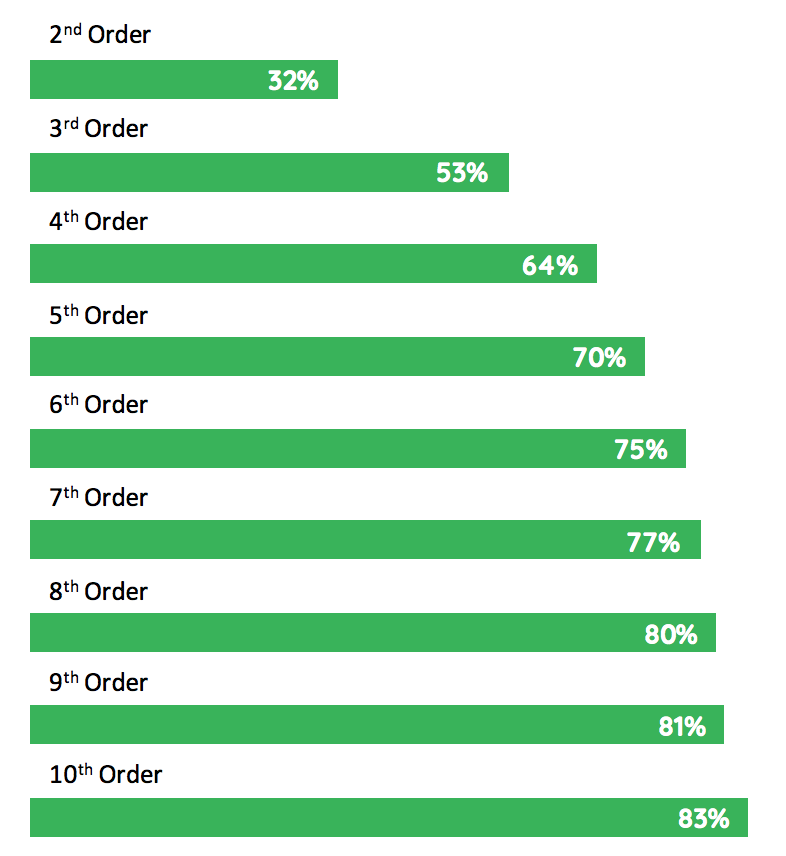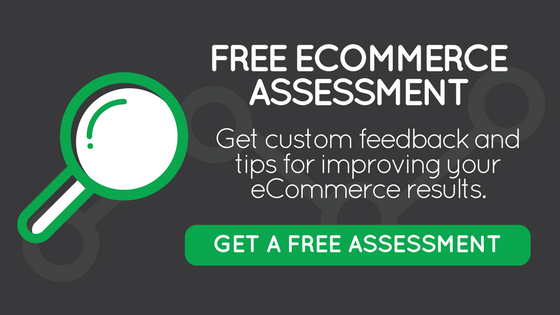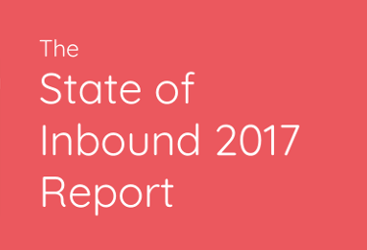eCommerce Inbound Marketing for Customer Retention
For many years, customer retention has played second fiddle to customer acquisition. However, in today’s world of rising customer acquisition cost, more and more companies are beginning to embrace the value of customer retention.
This guide is intended to help you understand the value of customer retention marketing and provide you practical step-by-step methods on: how to develop a customer retention strategy, tactics to increase order frequency and revenue, and tools your store can use to increase customer lifetime value.
Why is Customer Retention Important?
It is a well-known fact that marketing to an existing customer costs far less and is far more profitable than the cost of acquiring a new customer. Depending what industry, you’re in, acquiring a new customer can cost 5 to 25 times more than retaining an existing one. However, a clear majority of companies fail to prioritize marketing budgets, resources and programs to enroll repeat purchases. Forrester Research estimates that on average, 80% of marketing budgets are focused on new customer acquisition.
Another study conducted by Frederick Reichheld of Bain & Company (the inventor of the net promoter score) concluded that increasing customer retention rates by as little as 5% can increase profits by 25% to 95%.
Increasing customer retention rates by as little as 5% can increase profits by 25% to 95%.-- Frederick Reichheld of Bain & Company
In today’s world, it is has become easier than ever with platforms like Shopify, Magento, BigCommerce, WooCommerce and many other platforms to open an online store. With the flood of new online stores opening every day, this has increased competition, which in turn has increased the cost of customer acquisition.
Although acquiring new customers is still vitally important and getting more expensive, striking a balance in resources and attention with customer retention to create repeat purchases and loyalty is the key.
Customer retention marketing is about keeping your existing customers engaged and happy so they keep them coming back to make repeat purchases at your store.
Laying the Foundation
Ecommerce businesses are armed with a vast amount of customer data. The challenge is how to systematically analyze that data to develop effective strategies to increase customer value. Another valuable attribute of Ecommerce businesses is utilizing real time customer interaction and order processing data to create actionable events that increase customer value.
Before we start diving into how to do customer retention marketing, let’s explore how to estimate the value of your existing customer base and how to develop strategies that increase the value of your existing customers base. To do this, we will explore 5 frameworks to begin laying the foundation:
- A Simple Way to Calculate Customer Lifetime Value (CLV)
- Understand the Power of Repeat Order Probability
- Segment your Customer Base Using RFM Analysis
- Create Relationship Context with Buyer Personas
- Design Buyers Journeys that Delight your Customers
A Simple Way to Calculate Customer Lifetime Value (CLV)
Customer lifetime value (CLV) is one of the most important metrics an Ecommerce business should be tracking. CLV enables you to determine the value of each customer, and how much you can spend to acquire and retain each customer. This metric becomes more insightful when you begin segmenting your existing customer base.
If you conducted a Google search on how to calculate CLV, you would find that there are many ways to calculate CLV.
Although more advanced methods for calculating CLV exist, we will provide a simple way for you to get the information you need to refine your approach to customer acquisition.
For this simple method, we will need to calculate the following variables:
- Average Order Size (AOS)
- Average Order Frequency (AOF)
- Customer Value (CV)
- Average Customer Lifespan (ACL)
If your current Ecommerce platform does not make this information readily available, you can export this data into a spreadsheet to perform the calculations. Columns required will be:
- Customer Name
- Total Revenue
- Number of orders by customers
- Number of days between first order date and last order date
If you need to calculate this manually, download your customer data with the columns highlighted above and follow the 5 steps outlined below.
Step 1: Calculate Average Order Size (AOS)
The average order size (AOS) is the average amount of money that a customer spends each time they place an order.
Your average order size is calculated by calculating your total customer revenue for a given period and dividing the total orders performed by these customers to calculate your average order size.
Average Order Size (AOS)
AOS = Total Revenue / Total # of Orders
Step 2 Calculate Average Order Frequency (AOF)
The average order frequency (AOF) represents the average amount of orders placed by each customer.
Your average order frequency (AOF) is calculated by calculating the total number of orders for a given period and dividing the total number of customers for a given period.
Average Order Frequency (AOF)
AOF = Total # of Orders / Total # of Customers
Step 3: Calculate Average Customer Value (ACV)
The average customer Value (ACV) is the average revenue value that each customer brings to your business during a given timeframe.
The average customer value can be determined by multiplying the average order size (AOS) with the average order frequency (AOF).
Average Customer Value (ACV)
ACV = AOS / AOF
Step 4: Calculate Average Customer Lifespan (ACL)
The average customer lifespan is the average time between the number of days between first order date and last order date of all of your customers. Convert the average number of days into years. For example, if you determine that the ACL is 1,277.5 days, this would equate to an ACL of 3.5 years.
Average Customer Lifespan(ACL)
ACL = 1st Order Date - Last Order Date
Step 5: Calculating the Customer Lifetime Value (CLV)
To calculate your average customer lifetime value (CLV) using this simple method, multiple your average customer lifespan (ACL) to your average customer value (ACV).
Customer Lifetime Value (CLV)
CLV = ACL / ACV
Bringing everything together, using the data below as an example, we can determine that the average customer lifetime value is $187.50.
|
Variables |
Data |
Formula |
Total Revenue |
$25,000,000 |
|
|
Total # of Customers |
2,000,000 |
|
|
Total # of Orders |
$500,000 |
|
|
Average Order Size (AOS) |
$50.00 |
AOS = Total Revenue / Total # of Orders |
|
Average Order Frequency (AOF) |
1.5 |
AOF = # of Orders / # of Customers |
|
Average Customer Value (ACV) |
$75.00 |
ACV = AOS X AOF |
|
Average Customer Lifespan (ACL) |
2.5 |
ACL = 1St order date - last date |
|
Customer Lifetime Value (CLV) |
$187.50 |
CLV = ACL X ACV |
|
Gross Margin% |
50% |
|
|
CLV Gross Margin Contribution |
$93.75 |
Ultimately, to determine the CLV margin contribution for each customer, we can multiply the gross margin percentage to CLV to calculate the CLV grow margin contribution. In this example, with a gross margin percentage of 50%, our CLV grow margin contribution would be $93.75 to determine how much money we should budget to acquire and retain customers.
Not all customers are valued equally. Depending on the type of business you are in, you can further segment your customer base in order to gain insights on the value of each segment:
- Most Purchases
- Geography
- Product and service line
- Order frequency
- Order value
Tactics to Increase Customer Lifetime Value
Based on the variables used to calculate customer lifetime value, it is evident that by increasing the average order size (AOS), average order frequency (AOF) or both, we can increase customer lifetime value. In addition to these variables, average conversion rates can influence the customer lifetime value. Below are some tactics to increase customer lifetime value:
- Tactics for increasing average order frequency
- Nurturing the rights customers, with personalized content and offers, at the right time with email marketing campaigns
- Stay in front of customer with retargeting ad campaigns
- Create a loyalty program that rewards order frequency
- Customer Service and Return Programs
- Tactics for increasing average order size
- Offer free shipping with order sizes of $X
- Present bundled offers
- Present upsell and cross-sell offers
- Create a loyalty program that rewards spending levels
- Tactics for increasing conversion rates
- Provide social proof with online reviews
- Personalize content and offers to the right customer at the right time
- Provide free shipping
- Offer discounts
- Provide exit offer on checkout
Understand the Power of Repeat Order Probability
RJ Metric conducted a survey of 176 Ecommerce retailers and 18 million customers to uncover insights on how Ecommerce customers behave. The survey found that after a customer has placed an initial order, that same customer has a 32% chance of returning to your store to place another order. If that same customer comes back to make a second purchase, there is 54% they will place another purchase!
See where we’re going with this? As the customer keeps returning, the percentage of placing another order continues to increase.
Repeat Order Probability

As this survey concludes, it is abundantly clear that if you can proactively engage existing customers to return to your store, the potential customer lifetime value can skyrocket the more often they order.
To see the probability of customers that made (x) orders to make (x+1) orders, simply divide the number of people who've made at least (x+1) purchases by the number of people who have made at least (x) purchases.-- RJ Metrics "Understanding the Repeat Order Probability Report"
If you wish to calculate the repeat order probability for your store, below is an example of calculating the repeat order probability of a customer making a second order at your store.
Example:
# of customers who placed 1 order: 1,000
# of customers who placed 2 orders: 350
# of customers who place 3 orders: 130
In this example, the repeat order probability of customers who have placed one order in their lifetime to placing a second order is: (350 + 130) / (350+130+1,000) = 32.43%
Segmenting Your Customer Base With RFM
All your customers are NOT valued equally. Some customers are worth a lot, while others are worth little to nothing.
RFM segmentation is a framework for segmenting your customers based on their buying behavior:
- Recency - the last time that a customer made a purchase. A recent purchasing customer is more likely to make another purchase than a customer who hasn’t made a purchase in a long time.
- Frequency - how many times a customer has made a purchase within a given time frame. A customer who makes frequent purchases is more likely to continue to make purchase than a customer who rarely makes purchases.
- Monetary Value - the amount of money a customer has spent within that same time frame. A customer who spends more is likely to return than a customer who spends less.
When RFM segmentations is combined with a marketing automation tool (e.g., Hubspot) you’ll be able to leverage this segmentation in real time to deliver the right content and offer, to the right customer at the right time.
How to Segment Your Customer Using RFM
To perform an RFM segmentation analysis, export your customer data with the following columns by customer:
- Customer name
- First order date
- Last order date
- Number of orders
- Total revenue
Assign a RFM Score for Each Customer
The first step in building an RFM model is to assign a Recency, Frequency and Monetary (RFM) score to each customer. Scoring will vary depending on the degree you want to segment your customers. For this example, we will segment customers by quintiles (i.e., dividing your customer data into five groupings by RFM segment).
For example, a customer base dataset might be scored in the following manner by RFM segment:
Example of RFM Scores by Segment
Order Recency Score
- Order Recency = 5 (ordered in the last 30 days)
- Order Recency = 4 (ordered in the last 31 to 60 days)
- Order Recency = 3 (ordered in the last 61 to 120 days)
- Order Recency = 2 (ordered in the last 121 to 180 days)
- Order Recency = 1 (ordered more than 181 days ago)
Order Frequency Score
- Order Frequency = 5 (14 or more orders)
- Order Frequency = 4 (between 9 and 13 orders)
- Order Frequency = 3 (between 4 and 8 orders)
- Order Frequency = 2 (between 2 and 4 orders)
- Order Frequency = 1 (1 order)
Monetary Score
- Monetary = 5 (ordered more than $351)
- Monetary = 4 (ordered between $201 and $350)
- Monetary = 3 (ordered between $151 and $200)
- Monetary = 2 (ordered between $51 and $150)
- Monetary = 1 (ordered less than $50)
Once you have established your scoring baseline, you can establish an RFM score for each customer.
It is common when discussing RFM scores to use short notations such as 3-4-3 to describe a group that has scored: recency of 3, frequency of 4 and monetary of 3. With these segments defined, you can select groups of customers and develop relevant campaigns that are in context with their relationship with your store.
How to leverage RFM Segmentation
It is helpful to assign names to segments and place them in groups. Here are just a few examples:
|
RFM Group Examples |
Pro Tip |
|
VIP’s: This group consists of those customers with high monetary scores of 5 or 4. |
|
|
New Big Spenders: This group consists of recent customers who ordered once and bought a lot with scores such as: 5-1-5 and 5-1-4. |
|
|
Lower Spending Loyal Customers – This group consists of those customers in segments 5-5-3 and 5-5-4 (they transacted recently and do so often, but spend the least). |
|
|
Disengaged Customers - This segment customers are found in groups R-1 and have not ordered in a long time. |
|
Create Relationship Context with Buyer Personas
Buyer personas describe in detail who your buyers are. If you know who they are, you can be in context with them to create personalized relationships.
Why do your customer personas matter?
My son and I do a lot of speaking across the country spreading the word about inbound. Inevitably, when we start introducing the importance of customer personas we get some blank stares. At that point, I segue into how in the physical world when we are enrolling a prospective customer, we have to relate in context at a human level. When this happens we always find ourselves connecting and communicating in a fluid way. The same is true in the digital world. When we know who our customer persona is, we can connect and communicate in a similar fashion in the digital world.
So, let’s break this down. We begin by defining the market segments that best align to our value proposition. Next, we can identify who the buyers are in those market segments. These buyers are customer personas. In today’s world, we have unprecedented tools and data that allow us to define who these customer personas are with precision and speed. Facebook Audience Insights is one amazing tool that makes this possible.
Customer personas can empower you to improve your products and services based on your customers’ needs. It also helps you create content that aligns with your customers context – allowing you to facilitate them naturally through a buyer's journey, just like you would in the physical world. Identifying needs, providing options to address those needs and addressing pressing questions prior to making a purchase.
Welcome to the Power of Facebook Audience Insights
Facebook is not just a platform where you can connect with your customers. As part of Facebook's advertising platform, Facebook provides a powerful and free tool called Facebook Audience Insights. This tool enables you to create data rich customer personas with precision. The good news is that this tool provides a wealth of insightful data and it’s free!
How does Facebook do this? First, when users create their profiles, they typically supply information like their name, email, phone number, date of birth, job title, and relationship status. As these users begin using Facebook, Facebook begins tracking and developing a profile around activity level, device usage, location, language, post, likes, friends, shares, etc. Facebook then combines this organic data with some of the largest data aggregators in the world including Epsilon, and Acxiom. Armed with this data, Facebook's Audience Insights can provide you customer persona data that includes:
- Demographics and interests
- Lifestyle preferences
- Education level
- Estimated household income
- Home ownership and market value
- Spending methods
- Purchasing behavior and estimated retail spending
- Types of cars purchased
- And much more.
Creating customer personas using Facebook Audience Insights
So how can this be done?
Step 1: Import an existing customer list
Download your existing customer list to include email addresses or phone numbers into a CSV file. Next, go to Facebook Ads Manager, select the Tools menu, and select Audiences.
There you’ll see a dropdown menu called Create Audience; in that menu, choose Custom Audience.
Click on Customer File.
Select Add customers from your own file or copy and paste data.
Click Upload File and upload your data.
After Facebook Audience Insights processes the uploaded list, you’ll see a ‘Ready’ notification. It may take up to an hour to receive the ‘Ready’ notification, so be patient. Once the data is ‘Ready” you’re ready to analyze your Custom Audience.
Step 2: Analyze your Custom Audience
Next, go to your Audience Insights tool, which is found under the Tools menu in your Facebook Ads Manager.
You’ll then be prompted to choose an audience to analyze. Select one or more of the Custom Audiences you’ve created.
Once selected, you’ll see the data presented in Audience Insights. This data is grouped by: Demographics, Page Likes, Location, Activity, Household and Purchase. Below is a small snapshot of the wealth data available in Facebook Audience Insights.
Step 3: Create your customer persona
Now that you have Audience Insights data, you can now use this data to create customer personas. When creating the customer persona, you want to describe a real person as if you were going to introduce this person to someone. For example, your customer persona could be summarized as follows.
 Diane is a 30-year-old married woman and with 2 children. She’s got a college degree in marketing, makes $90,000 a year and owns a home worth $400,000. She drives a luxury SUV car and she predominately eats out and purchases fashionable clothing and beauty products, and subscription services. She listens to NPR and watches liberal and progressive news on TV and listens to podcast.
Diane is a 30-year-old married woman and with 2 children. She’s got a college degree in marketing, makes $90,000 a year and owns a home worth $400,000. She drives a luxury SUV car and she predominately eats out and purchases fashionable clothing and beauty products, and subscription services. She listens to NPR and watches liberal and progressive news on TV and listens to podcast.
Once your persona has been created, match a photo that you think best suits this person. Repeat this process for each segment you serve, and buyers within those segments until you've developed a full suite of personas that reflect your target customer base.
Now that you’ve created your customer personas using Facebook Audience Insights, it’s time to create a buyer's journey for each persona.
Designing a Buyer’s Journeys that Delights your Customers
A lot has changed since that inception of the Internet. In the pre-Internet world, information about products and services was not readily available and buyers relied heavily on salespeople to get access to the information needed prior to making an informed buying decision. In today’s Internet world, information is readily available for buyers conduct research prior to making a buying decision.
Ecommerce Inbound Methodology
The Ecommerce Inbound Methodology provides a simple buyer’s journey framework on how to attract, convert, close and delight your ideal customers in today’s Internet world. All of us today don’t want to be sold, we want to be helped and advised on how to make good buying decision. Therefore, the intent of the Ecommerce Inbound Methodology is to provide the the right customer, the right content and offer, at the time to help and advise them to make informed buying decisions.
Ecommerce Inbound is about knowing your customers (i.e., customer personas) and providing them the right content and offers, at the right time. It’s also about nurturing them through a buyer’s journey that helps them every step of their buyer’s journey. When designed well, the buyer’s journey is focused on helping your customer.
With your customer personas in mind, retailers can design a buyer experience that effectively nurtures visitors in each stage of the buyer’s journey - attract, convert, close, and delight - with the goal of having them become repeat customers.
The buyer’s journey is the process buyers go through to become aware of, evaluate, and purchase a new product or service. The journey is a four-step process:
- Attract Stage: The buyer realizes they have a problem or desire, and begins doing research.
- Convert Stage: The buyer defines their problem and researches options to solve it.
- Decision Stage: The buyer weighs options available and makes an informed purchase.
- Delight Stage: Provided customer has had a good experience, they can be nurtured into making repeat purchases and may be happy to evangelize your brand.
Let’s explore each of these stages in more detail.
Attract
At the inception of the buyer’s journey, buyers are likely to be unaware of two things: your brand, and that they have a need. At this stage, they are doing research on a problem they have and seeking solutions to address that problem. In a majority of cases that research is being done on Google.
Half of shoppers spend at least 75% of their total shopping time conducting online research.
72% of buyers turn to Google during attract stage research; 70% return to Google in consideration stage research.
As a marketer, your job at this attract stage is to know your buyer (i.e. persona), anticipate the types of problems they will be doing research for, and create the content that help your buyer address the problem. The content you create should be focused on your buyer’s problem and pain points — not your product, service or brand.
Nurtured leads produce, on average, a 20% increase in sales opportunities versus non-nurtured leads. -DemandGen Report
To connect with buyers at this stage, the following inbound tactics are applied:
- Generate Content specifically for the Attract stage: Providing helpful educational content like blog post, eBooks, infographics, videos, reports that help your buyer address their problem. Optimize this content so they can be found on Google. Remember to lay off the sales pitch at this stage in the buyer’s journey, it is all about building trust with your buyers and establishing your brand as a trustworthy source of helpful information.
- Social Publishing: Engage with buyers on the social media channel they are using and repurpose your content for this stage to help buyers with their problems.
- Paid Search: Expand the reach of your content by placing ads targeting your ideal buyer centered on this problem domain.
- Activate Marketing Automation: In exchange of this type of valuable content for your buyers at this stage, you can begin developing a few simple lead nurturing campaigns.
Convert
Once buyers have narrowed down their options, they typical return to the research stage again to evaluation their options to conclude their research.
70% of buyers return to Google at least 2-3 times during their research.-Pardot’s State of Demand Generation Report
At some point in their research, buyers will begin doing comparisons of each product or service they are considering. This is the stage where they can really drill down into the features that matter to them.
- Generate Content specifically for the Convert Stage: Again, provide helpful educational content to help the buyer evaluate their options to help them make an informed buying decision. For example, you could consider creating a comparison guide that includes competitive offerings to help your buyer through this part of their research.
- Comparison Features: Provide your buyers the ability to easily compare your product/service offering features and benefits.
- Free Trials: Offer free trials of your products or services to ensure product and service fit.
- Leverage Marketing Automation: Marketing automation tools will enable you to track of the activities (e.g., downloads, page visited and time spent on those pages) of you buyers as they progress through their journey and progressively scoring their buyers intent.
Close
At this stage, your buyer is prepared to make a buying decision. They have concluded their research and are now prepared to make a purchase.
77% of consumers read product reviews before making an online purchase-Business.com
- Mobile Friendly: As more and more people are making online purchases using their mobile devices, having a mobile friendly store and easy checkout process is vital. If fact, in 2017 60% of visits to ecommerce sites will come from smartphones.
- Videos: Include video on your product and service pages. StacksAndStacks reported that visitors were 144% more likely to make a purchase after seeing a product video than those who did not.
- Online Reviews: Reviews are highly effective when it comes to nudging your potential customers to make a purchase. In fact, 55% of shoppers find reviews important for making purchase decisions, and 69% of online shoppers want more reviews from ecommerce sites.
- Online Chat: Depending on what type of product you sell; online chat can provide customers immediate questions to questions they have prior to making a purchase.
- Coupons and Incentive Offer: Discounts and incentive offers like free shipping influential in purchase decisions.
- Risk Free Return Policy: Depending on your business, a risk-free return policy not only improves conversion rates and help strengthen brand loyalty.
- Site Speed: Slow site speed is like waiting in a long like at checkout. Customer are busy and don’t like to wait for your store to respond to their request.
- Abandon Carts: Abandon carts happen for a variety of reasons. However, in many cases, customers welcome being reminded of purchases they were in the process of making.
- Easy Checkout Process: To minimize abandon carts, streamline your checkout process.
Delight
At this stage, if everything went well with their purchase, and your buyers are happy with where they’ve ended up at the end of their journey, they can become a valuable marketing resource. Customer evangelists, who can speak positively about your product and the experience they’ve had with your company, are a powerful resource — and one that companies should work hard to cultivate.
- Personalization: Your ecommerce platform is filled with rich customers data including: purchases make, recency, frequency and total purchase value. All of this information can be leveraged to create personalized shopping experiences. In fact, 75% of consumers are more likely to buy from a retailer that recognizes them by name, recommends options based on past purchases, or knows their purchase history.
- Customer Service: It is inevitable that customers will encounter problems with their shopping experience with your store. Provided you are prepared to effectively engage in this experience will determine if you have lost a customer or are able to create a customer for life.
- Loyalty Program: Design and enroll your customers into a loyalty program. Loyalty programs can help influence: purchase frequency, referrals, online reviews and more.
Conclusion
The intent of this guide was to help you understand the value of eCommerce Inbound Marketing for customer retention and provide you practical step-by-step methods on: how to develop a customer retention strategy, tactics to increase order frequency and revenue, and tools your store can use to increase customer lifetime value.
About digitalJ2
digitalJ2 is an inbound marketing agency specializing in eCommerce, and traditional B2B and B2C businesses. We are a HubSpot certified gold partner providing standardized services and set pricing. Our mission is to help our customer grow and to make those who believed in us look brilliant.
Have questions?
Similar Posts:







